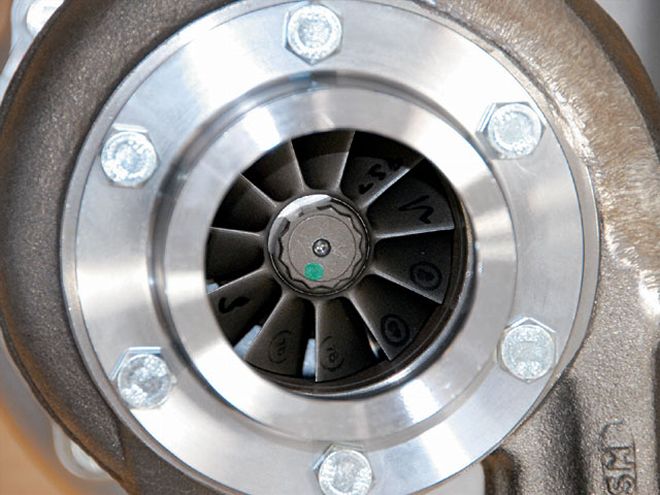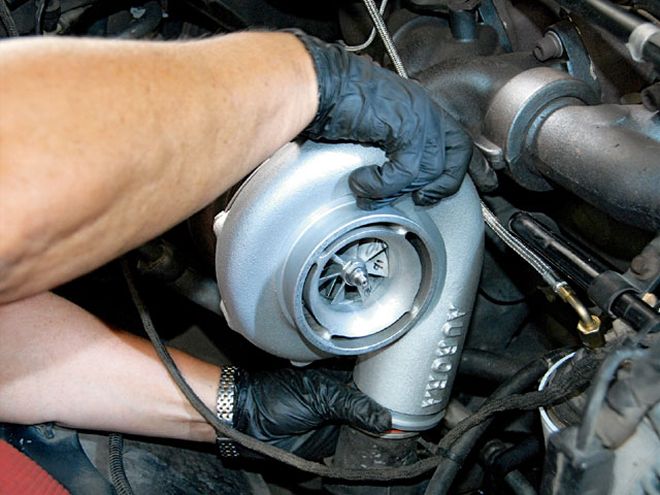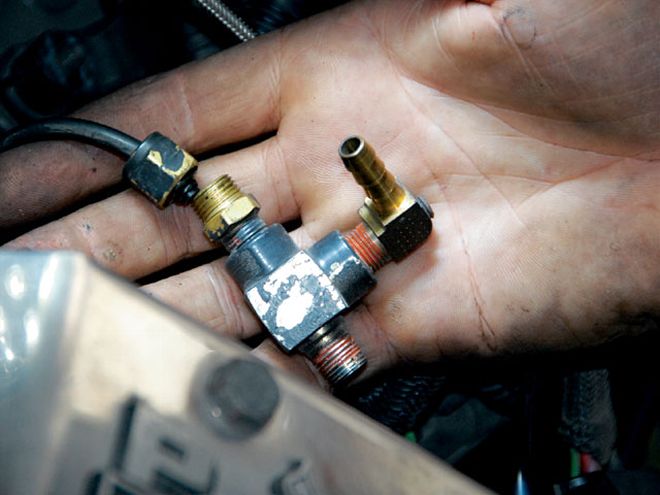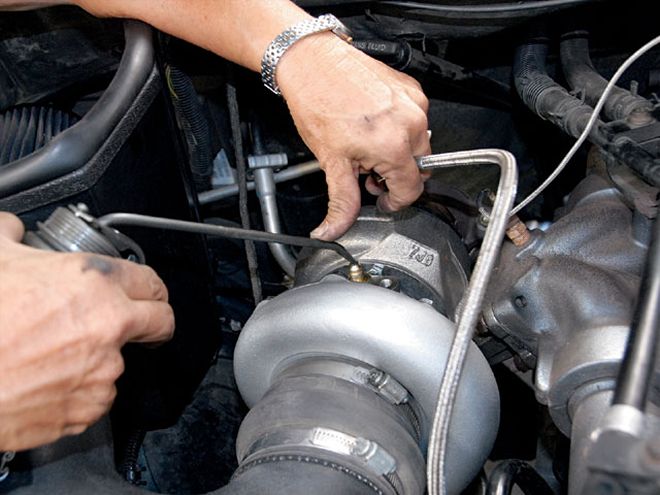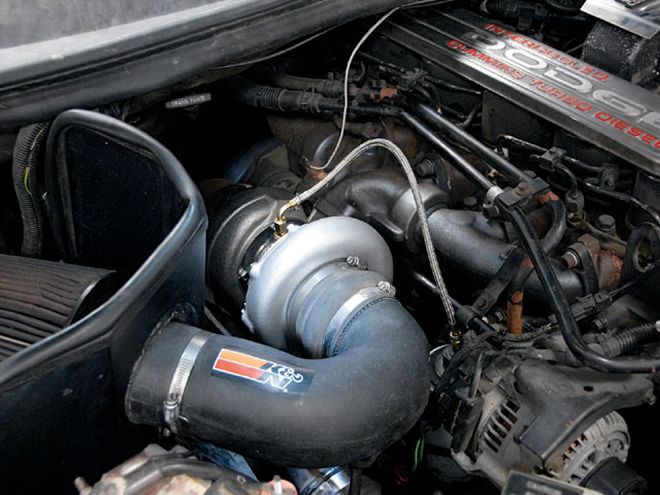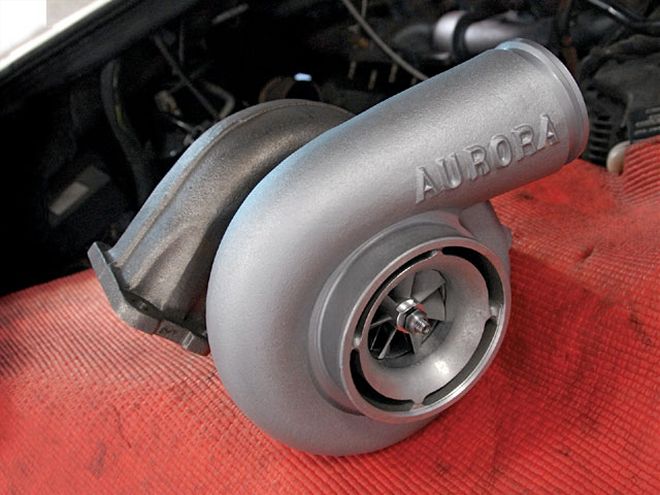
| While the Aurora 2000 turbo's overall size is fairly similar to the factory unit, the internals are vastly different to improve efficiency and reduce operating temperatures for better airflow.
The thing that makes a turbocharged diesel such a wonderful engine really comes down to the interaction between two simple things: air and fuel. The more diesel fuel you can burn, the more power you'll have on tap, and that requires pushing as much air as possible into the cylinders-which is where the turbo comes into play.
As most of you already know, expanding hot gases from the engine's exhaust manifold(s) spin the turbocharger's turbine wheel, causing it to turn the compressor wheel. The compressor, basically an air pump, creates boost that pressurizes the engine's intake. This increased airflow to the engine improves the efficiency of the burn cycle, with the end result being increased power output and lower exhaust gas temperatures.
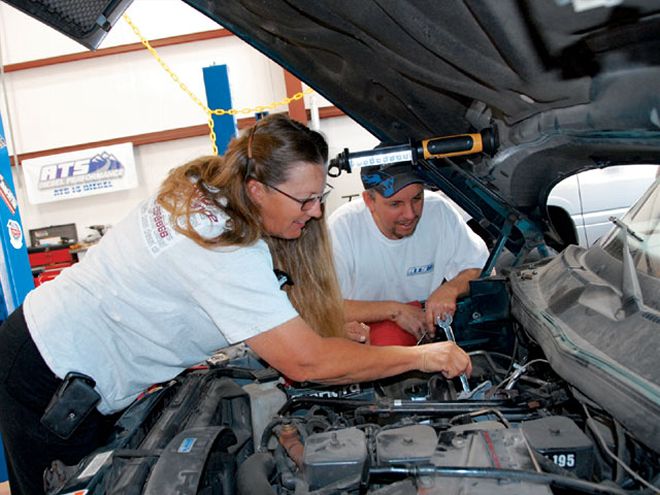
| Removing the stock Holset HX35 turbo is a fairly simple process. It unbolts from the four-bolt flange on the exhaust manifold and requires disconnecting a few hoses and the oil line. Rob Hancock and Betty Sutherland pitched in to help with the swap.
Of course, not all turbos are created equal. Some push more air than others because of their size and design, and depending on the application, bigger isn't necessarily better. For instance, the 12-valve Cummins-powered '96 Dodge Ram we used for this article is primarily a work truck used for towing boats over fairly long distances-not bombing down the dragstrip. So while more horsepower is welcome, extra torque is necessary for this particular truck. Clint Cannon, president of ATS Diesel, points out that for towing and hauling, an output of up to 450 hp is ideal, but higher levels are more for sport and competition applications.
Choosing A TurboWhen it came time to upgrade the stock Holset HX35 turbo on our Cummins, we chose the Aurora 2000. ATS offers five different levels of turbochargers and has just introduced a new compound dual-turbo kit. As much as we like the sound of two high-performance pinwheels on a diesel, this truck's got a job to do, so we opted for somewhat more modest gains. The Aurora 2000 turbo is designed for fast response and improved low and midrange torque while reducing EGT and maintaining good fuel economy.
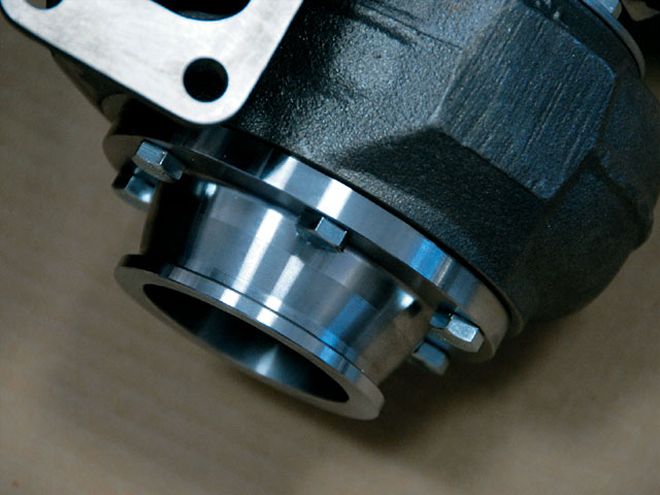
| This machined section on the exhaust outlet adapts the Aurora's turbine housing to work with the factory exhaust downpipe.
As such, the Aurora 2000 model offers some substantial improvements over the stock turbo. The ATS Web site's data charts indicate the Aurora's airflow is 877 cfm versus 555 cfm for the Holset-roughly a third more. The output of the factory turbo is 295 hp, while the Aurora can produce 466 hp (depending on other modifications to the injectors, intake, and exhaust-all of which had already been done on this particular truck).
Spool time is also reduced with the Aurora, dropping from 6.1 to 3.7 seconds. Interestingly enough, even though the airflow and potential power-output numbers are much higher, the increase in max boost is not that much greater. The stock turbo can make around 35 psi, and the Aurora is good for 40 psi. That's because the Aurora works smarter-not harder-by increasing the compressor's output. We won't get overly technical about the internal design of the compressor wheel; it features several improvements in the blade shape and angle along with the diameter and housing.
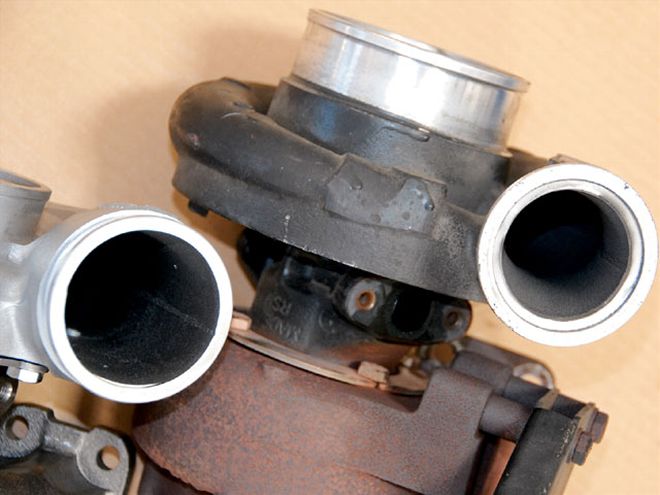
| The diameter of the compressor discharge outlet opening on the Aurora (left) is bigger than the stock turbo as well-211/42 versus 2 inches.
"Small changes in size can make huge changes in the compressor," Cannon says. "(The Aurora 2000) also produces less heat for a denser air charge and more airflow."
Another significant difference in the Aurora line of turbos is what it doesn't have: an internal wastegate. Typically, this feature is used to relieve backpressure and also allows for a smaller turbine housing. How did ATS dispense with this item?
"The turbine wheel and housing are matched to the volumetrics of the engine," Cannon says. "They absorb all the energy of the gas for more efficiency." With less restriction in the turbine housing, no wastegate is needed, so there's more flow and less drive pressure. This configuration, however, requires meticulous matching of the turbine and compressor and a different type of internal design.
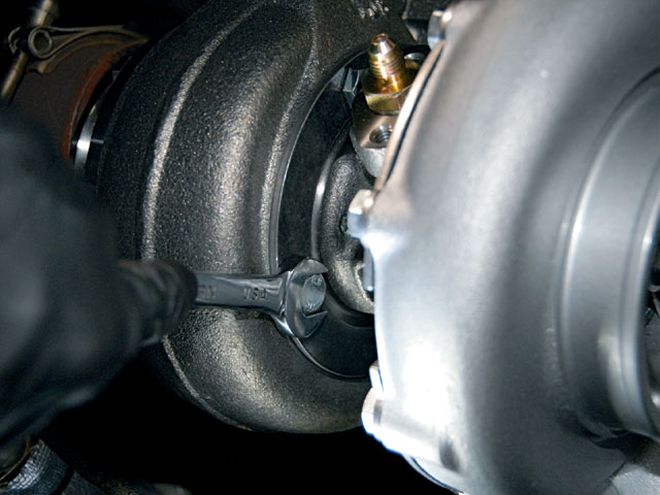
| The snap ring that holds the Aurora's compressor housing to the backing plate uses a universal bolt-up design and allows for clocking in any direction. Loosen the bolt to rotate the turbo and align it with the air-intake tube that leads to the intercooler.
Installing The AuroraReplacing the factory turbo is a simple swap. Installation of the ATS unit was fairly quick (just a couple of hours) thanks to some friendly help from mechanic Rob Hancock and Betty Sutherland, who runs Sutherland Diesel Performance, an ATS dealership in Palmdale, California.
The Dodge Ram we worked on already has several other mods on it, such as a K&N air filter, a #8 fuel plate, an ATS exhaust manifold, and a Banks exhaust, so providing before-and-after numbers would be somewhat exaggerated by the other upgrades.
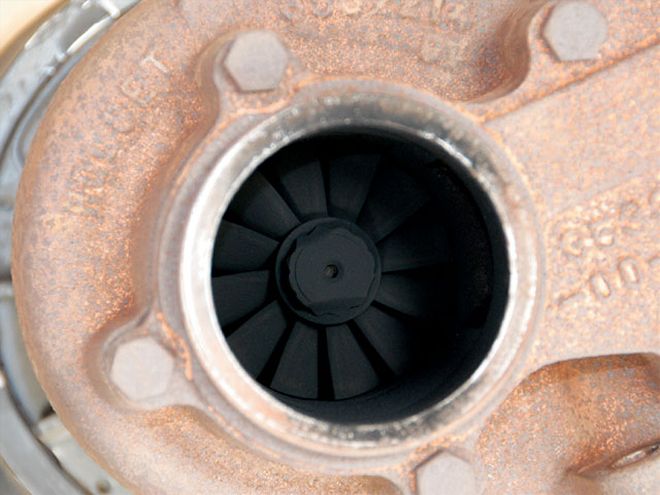
| aurora 2000 Turbo Upgrade interior
Instead, we'll share a brief anecdote to illustrate the improved output. On the way back to Los Angeles from Palmdale, while we were cruising in the left lane on the freeway enjoying the high-tech hum of the new Aurora, we encountered a poser driving one of those goofy tuner cars (they're as common as taco stands in Southern California). Seems this guy felt he shouldn't have to follow a 1-ton diesel dualie in the fast lane, so he passed us on the right, waving a single-finger salute.
While we had no desire to get mixed up in some sort of road-rage incident, we also just couldn't let things be and decided to spool up the ATS Aurora turbo even higher and show Mr. Tuner Guy what he was messing with. We had no trouble staying right on the bumper of his pimped-out performance car for several miles. Judging from the way the car darted from lane to lane, he probably thought we were going roll right over him. We eventually got bored with this little game, but next time, he'll know better than to tangle with a diesel pickup with a performance turbo.
 | While the Aurora 2000 turbo's overall size is fairly similar to the factory unit, the internals are vastly different to improve efficiency and reduce operating temperatures for better airflow.
The thing that makes a turbocharged diesel such a wonderful engine really comes down to the interaction between two simple things: air and fuel. The more diesel fuel you can burn, the more power you'll have on tap, and that requires pushing as much air as possible into the cylinders-which is where the turbo comes into play.
As most of you already know, expanding hot gases from the engine's exhaust manifold(s) spin the turbocharger's turbine wheel, causing it to turn the compressor wheel. The compressor, basically an air pump, creates boost that pressurizes the engine's intake. This increased airflow to the engine improves the efficiency of the burn cycle, with the end result being increased power output and lower exhaust gas temperatures.
| While the Aurora 2000 turbo's overall size is fairly similar to the factory unit, the internals are vastly different to improve efficiency and reduce operating temperatures for better airflow.
The thing that makes a turbocharged diesel such a wonderful engine really comes down to the interaction between two simple things: air and fuel. The more diesel fuel you can burn, the more power you'll have on tap, and that requires pushing as much air as possible into the cylinders-which is where the turbo comes into play.
As most of you already know, expanding hot gases from the engine's exhaust manifold(s) spin the turbocharger's turbine wheel, causing it to turn the compressor wheel. The compressor, basically an air pump, creates boost that pressurizes the engine's intake. This increased airflow to the engine improves the efficiency of the burn cycle, with the end result being increased power output and lower exhaust gas temperatures.
 | Removing the stock Holset HX35 turbo is a fairly simple process. It unbolts from the four-bolt flange on the exhaust manifold and requires disconnecting a few hoses and the oil line. Rob Hancock and Betty Sutherland pitched in to help with the swap.
Of course, not all turbos are created equal. Some push more air than others because of their size and design, and depending on the application, bigger isn't necessarily better. For instance, the 12-valve Cummins-powered '96 Dodge Ram we used for this article is primarily a work truck used for towing boats over fairly long distances-not bombing down the dragstrip. So while more horsepower is welcome, extra torque is necessary for this particular truck. Clint Cannon, president of ATS Diesel, points out that for towing and hauling, an output of up to 450 hp is ideal, but higher levels are more for sport and competition applications.
Choosing A TurboWhen it came time to upgrade the stock Holset HX35 turbo on our Cummins, we chose the Aurora 2000. ATS offers five different levels of turbochargers and has just introduced a new compound dual-turbo kit. As much as we like the sound of two high-performance pinwheels on a diesel, this truck's got a job to do, so we opted for somewhat more modest gains. The Aurora 2000 turbo is designed for fast response and improved low and midrange torque while reducing EGT and maintaining good fuel economy.
| Removing the stock Holset HX35 turbo is a fairly simple process. It unbolts from the four-bolt flange on the exhaust manifold and requires disconnecting a few hoses and the oil line. Rob Hancock and Betty Sutherland pitched in to help with the swap.
Of course, not all turbos are created equal. Some push more air than others because of their size and design, and depending on the application, bigger isn't necessarily better. For instance, the 12-valve Cummins-powered '96 Dodge Ram we used for this article is primarily a work truck used for towing boats over fairly long distances-not bombing down the dragstrip. So while more horsepower is welcome, extra torque is necessary for this particular truck. Clint Cannon, president of ATS Diesel, points out that for towing and hauling, an output of up to 450 hp is ideal, but higher levels are more for sport and competition applications.
Choosing A TurboWhen it came time to upgrade the stock Holset HX35 turbo on our Cummins, we chose the Aurora 2000. ATS offers five different levels of turbochargers and has just introduced a new compound dual-turbo kit. As much as we like the sound of two high-performance pinwheels on a diesel, this truck's got a job to do, so we opted for somewhat more modest gains. The Aurora 2000 turbo is designed for fast response and improved low and midrange torque while reducing EGT and maintaining good fuel economy.

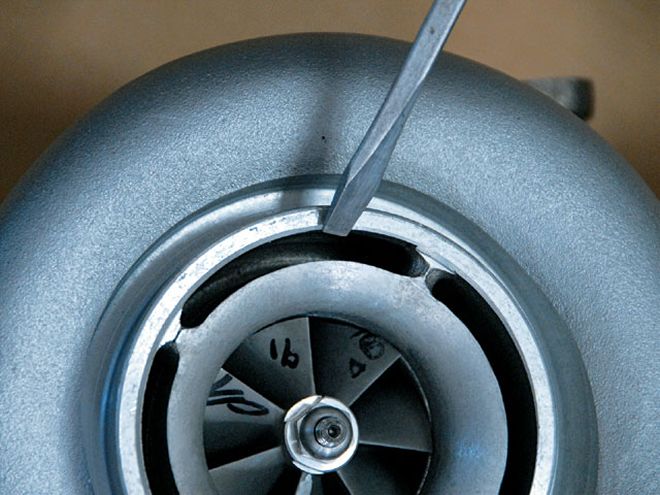
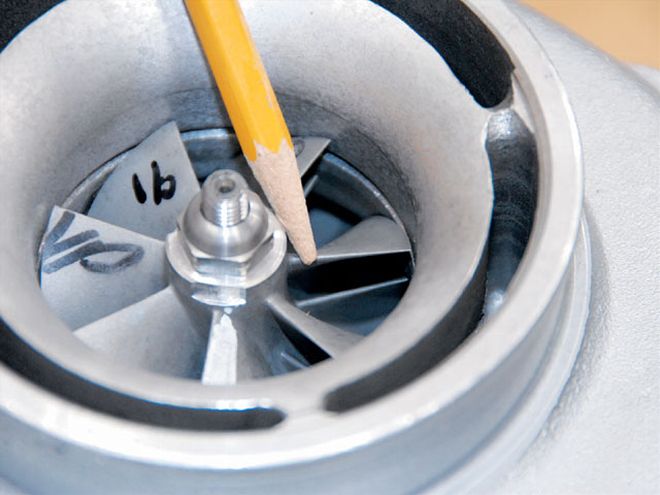
 | This machined section on the exhaust outlet adapts the Aurora's turbine housing to work with the factory exhaust downpipe.
As such, the Aurora 2000 model offers some substantial improvements over the stock turbo. The ATS Web site's data charts indicate the Aurora's airflow is 877 cfm versus 555 cfm for the Holset-roughly a third more. The output of the factory turbo is 295 hp, while the Aurora can produce 466 hp (depending on other modifications to the injectors, intake, and exhaust-all of which had already been done on this particular truck).
Spool time is also reduced with the Aurora, dropping from 6.1 to 3.7 seconds. Interestingly enough, even though the airflow and potential power-output numbers are much higher, the increase in max boost is not that much greater. The stock turbo can make around 35 psi, and the Aurora is good for 40 psi. That's because the Aurora works smarter-not harder-by increasing the compressor's output. We won't get overly technical about the internal design of the compressor wheel; it features several improvements in the blade shape and angle along with the diameter and housing.
| This machined section on the exhaust outlet adapts the Aurora's turbine housing to work with the factory exhaust downpipe.
As such, the Aurora 2000 model offers some substantial improvements over the stock turbo. The ATS Web site's data charts indicate the Aurora's airflow is 877 cfm versus 555 cfm for the Holset-roughly a third more. The output of the factory turbo is 295 hp, while the Aurora can produce 466 hp (depending on other modifications to the injectors, intake, and exhaust-all of which had already been done on this particular truck).
Spool time is also reduced with the Aurora, dropping from 6.1 to 3.7 seconds. Interestingly enough, even though the airflow and potential power-output numbers are much higher, the increase in max boost is not that much greater. The stock turbo can make around 35 psi, and the Aurora is good for 40 psi. That's because the Aurora works smarter-not harder-by increasing the compressor's output. We won't get overly technical about the internal design of the compressor wheel; it features several improvements in the blade shape and angle along with the diameter and housing.
 | The diameter of the compressor discharge outlet opening on the Aurora (left) is bigger than the stock turbo as well-211/42 versus 2 inches.
"Small changes in size can make huge changes in the compressor," Cannon says. "(The Aurora 2000) also produces less heat for a denser air charge and more airflow."
Another significant difference in the Aurora line of turbos is what it doesn't have: an internal wastegate. Typically, this feature is used to relieve backpressure and also allows for a smaller turbine housing. How did ATS dispense with this item?
"The turbine wheel and housing are matched to the volumetrics of the engine," Cannon says. "They absorb all the energy of the gas for more efficiency." With less restriction in the turbine housing, no wastegate is needed, so there's more flow and less drive pressure. This configuration, however, requires meticulous matching of the turbine and compressor and a different type of internal design.
| The diameter of the compressor discharge outlet opening on the Aurora (left) is bigger than the stock turbo as well-211/42 versus 2 inches.
"Small changes in size can make huge changes in the compressor," Cannon says. "(The Aurora 2000) also produces less heat for a denser air charge and more airflow."
Another significant difference in the Aurora line of turbos is what it doesn't have: an internal wastegate. Typically, this feature is used to relieve backpressure and also allows for a smaller turbine housing. How did ATS dispense with this item?
"The turbine wheel and housing are matched to the volumetrics of the engine," Cannon says. "They absorb all the energy of the gas for more efficiency." With less restriction in the turbine housing, no wastegate is needed, so there's more flow and less drive pressure. This configuration, however, requires meticulous matching of the turbine and compressor and a different type of internal design.
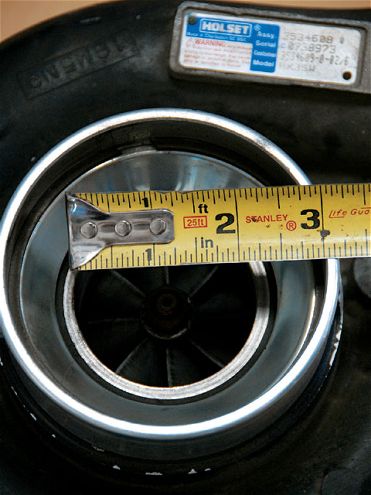
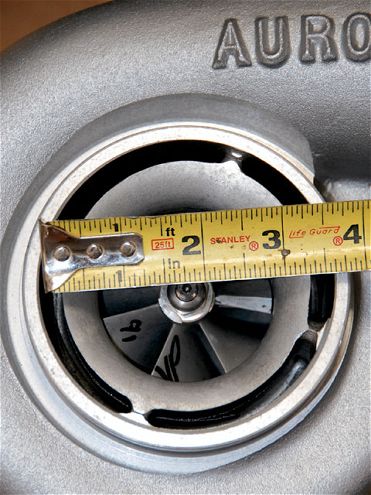
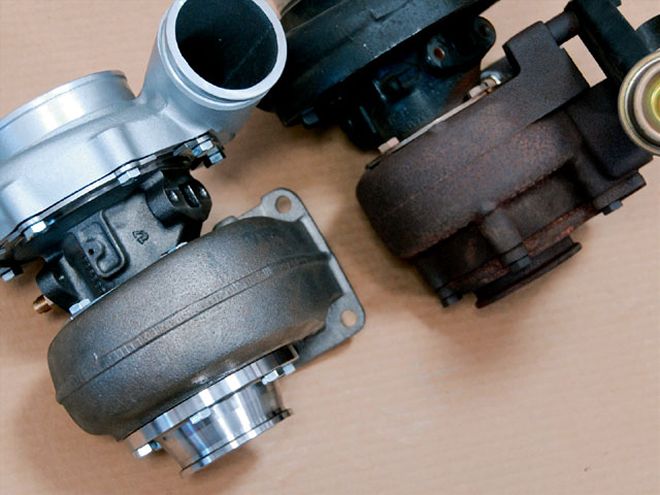
 | The snap ring that holds the Aurora's compressor housing to the backing plate uses a universal bolt-up design and allows for clocking in any direction. Loosen the bolt to rotate the turbo and align it with the air-intake tube that leads to the intercooler.
Installing The AuroraReplacing the factory turbo is a simple swap. Installation of the ATS unit was fairly quick (just a couple of hours) thanks to some friendly help from mechanic Rob Hancock and Betty Sutherland, who runs Sutherland Diesel Performance, an ATS dealership in Palmdale, California.
The Dodge Ram we worked on already has several other mods on it, such as a K&N air filter, a #8 fuel plate, an ATS exhaust manifold, and a Banks exhaust, so providing before-and-after numbers would be somewhat exaggerated by the other upgrades.
| The snap ring that holds the Aurora's compressor housing to the backing plate uses a universal bolt-up design and allows for clocking in any direction. Loosen the bolt to rotate the turbo and align it with the air-intake tube that leads to the intercooler.
Installing The AuroraReplacing the factory turbo is a simple swap. Installation of the ATS unit was fairly quick (just a couple of hours) thanks to some friendly help from mechanic Rob Hancock and Betty Sutherland, who runs Sutherland Diesel Performance, an ATS dealership in Palmdale, California.
The Dodge Ram we worked on already has several other mods on it, such as a K&N air filter, a #8 fuel plate, an ATS exhaust manifold, and a Banks exhaust, so providing before-and-after numbers would be somewhat exaggerated by the other upgrades.
 | aurora 2000 Turbo Upgrade interior
Instead, we'll share a brief anecdote to illustrate the improved output. On the way back to Los Angeles from Palmdale, while we were cruising in the left lane on the freeway enjoying the high-tech hum of the new Aurora, we encountered a poser driving one of those goofy tuner cars (they're as common as taco stands in Southern California). Seems this guy felt he shouldn't have to follow a 1-ton diesel dualie in the fast lane, so he passed us on the right, waving a single-finger salute.
While we had no desire to get mixed up in some sort of road-rage incident, we also just couldn't let things be and decided to spool up the ATS Aurora turbo even higher and show Mr. Tuner Guy what he was messing with. We had no trouble staying right on the bumper of his pimped-out performance car for several miles. Judging from the way the car darted from lane to lane, he probably thought we were going roll right over him. We eventually got bored with this little game, but next time, he'll know better than to tangle with a diesel pickup with a performance turbo.
| aurora 2000 Turbo Upgrade interior
Instead, we'll share a brief anecdote to illustrate the improved output. On the way back to Los Angeles from Palmdale, while we were cruising in the left lane on the freeway enjoying the high-tech hum of the new Aurora, we encountered a poser driving one of those goofy tuner cars (they're as common as taco stands in Southern California). Seems this guy felt he shouldn't have to follow a 1-ton diesel dualie in the fast lane, so he passed us on the right, waving a single-finger salute.
While we had no desire to get mixed up in some sort of road-rage incident, we also just couldn't let things be and decided to spool up the ATS Aurora turbo even higher and show Mr. Tuner Guy what he was messing with. We had no trouble staying right on the bumper of his pimped-out performance car for several miles. Judging from the way the car darted from lane to lane, he probably thought we were going roll right over him. We eventually got bored with this little game, but next time, he'll know better than to tangle with a diesel pickup with a performance turbo.
